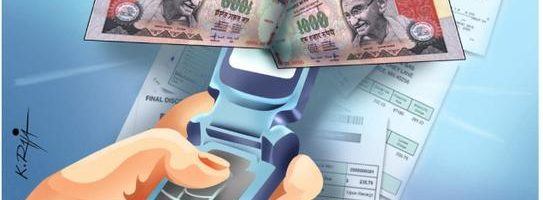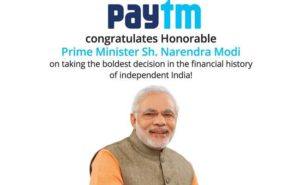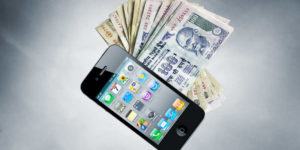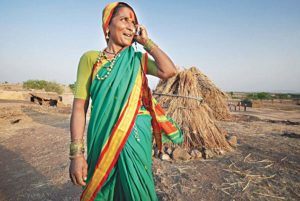‘Cashless Indian Economy’ – Money Demonetization to Mobile Digitization

India – traditionally a cash based economy – recently announced the biggest and most ambitious move to crack down black money and move towards digitization and cashless economy. While cards payments have struggled to scale up due to several reasons, can mobile based payment technologies such as mobile wallet pave the future for cashless economy in India?
Background
The payments landscape in India is undergoing a transformation: traditionally a cash-based economy, it has seen an increase in card-based and mobile transactions. In spite of advances made in the recent years by the Government and regulators to popularize cashless transactions, India continued to be a high-cash-usage economy. But on November 9th, 2016 Prime Minister Narendra Modi took entire India by surprise when he announced the demonetization of INR 500 and INR 1000 notes. There was a mad dash to withdraw smaller bills, or deposit bigger ones, at automatic teller machines around the nation before they shut down temporarily. This demonetization decision has been the biggest and most ambitious step ever to crack down on black money and fake currency and to move India towards a ‘cashless’ economy.
With INR 100 and lesser denomination notes in circulation, India has suddenly started seeing an upsurge in online transactions, card payments and mobile wallets to handle their daily expenses. But unlike rest of the economies where card payments have been the main source of paperless or plastic cash used for daily use, card payments have struggled to scale-up due to the fragmented nature of the retail sector – with its long tail of mom and pop stores – perception of it being expensive for small merchants, high cost of card payments hardware and lack of underwriting data for credit card issuance and merchant on boarding.
In such a scenario, mobile as a platform has a unique set of capabilities that can overcome the challenges posed by the Indian payments landscape. Mobiles offer a low-cost means to create financial access and payments. It can extend the last-mile reach of banking services either through business correspondents or directly to the end consumers. Improvements in the telecom infrastructure, access to internet connectivity and low-cost smartphones will eliminate the need for hardware based on fixed line connections. Mobile can be a platform that uniquely combines digital identity, digital value and digital authentication to create low-cost access to financial services.
In fact, since demonetization has come into effect, if there is a clear winner, it is the class of startups offering online wallets and digital payments. Mobile wallets have witnessed a massive rise in app downloads. Paytm’s traffic, for instance, increased by 435% and its downloads by 200%. Paytm is India’s leading mobile wallet startup – it allows users to make transactions “at 850,000 places across 1,200 Indian cities, including mom and pop shops, branded retail outlets, and petrol pumps. Paytm even advertised in newspapers, congratulating Prime Minister on the demonetization, calling it the “boldest decision in the financial history of independent India”.
So, can mobile wallets pave the way to a cashless economy?
The future of mobile wallets
According to analysts, by 2018 the mobile wallet market in India will grow at a CAGR of 140%, while the global mobile wallet market will register a CAGR of 34% by 2020. What’s fueling this optimism is the fact that India is one of the fastest-growing markets for smartphones in the world. It is expected to become the second largest market by 2017 – replacing the United States. The number of mobile internet users in India is expected to touch 314 million by 2017, up from 280 million now.
According to a recent report by GrowthPraxis, the market for mobile-enabled payments in India grew more than fifteen times between 2012 and 2015 to reach its current size of $1.4bn. Interestingly, nearly 60% of users accessed the internet for the first time on their mobile phones – in marked contrast to many other countries, where desktop and laptop are the first web-enabled devices that people use.
Earlier, most people used mobile internet for social networking sites, but that’s changing now – as increasing numbers of people are using it to make mobile payments.” Service providers are looking to make money by taking a cut from vendors, as the apps are free for customers. They are also flooding the market with cashback offers and discounts to get more traffic.
 But the question remains, can mobile wallets in India mirror the success that mobile payment tech has enjoyed in countries like Kenya, where more than 90% of the adult population has signed up to Vodafone’s M-pesa payment platform?
But the question remains, can mobile wallets in India mirror the success that mobile payment tech has enjoyed in countries like Kenya, where more than 90% of the adult population has signed up to Vodafone’s M-pesa payment platform?
Telecom infrastructure is improving and 3G & 4G services are being offered at very affordable prices, giving a huge boost to mobile commerce in the future. With 4G becoming more and more affordable with entry of telecom giants such as GIO, the digital wallets adoption in Tier 2 and Tier 3 cities is going to increase many folds. If reliable and fast mobile networks can make it out to rural areas, then mobile wallets should see huge growth in India. But it will still take a huge cultural shift to wean people off hard cash. (Words 797)
References
- http://scroll.in/article/821115/digital-wallet-apps-are-thrilled-with-narendra-modis-demonetisation-policy
- http://tech.economictimes.indiatimes.com/news/mobile/demonetisation-gets-mobile-wallet-companies-to-fast-forward-plans/55408598
- http://www.bbc.com/news/business-35341971
- http://economictimes.indiatimes.com/markets/expert-view/demonetisation-decision-was-a-logical-step-in-journey-towards-cashless-society-arun-jaitley/articleshow/55352466.cms
- http://www.investopedia.com/news/digital-payments-gain-indias-currency-demonetization/
- http://www.ey.com/Publication/vwLUAssets/EY-the-case-for-mobile-payments-in-india/%24FILE/EY-the-case-for-mobile-payments-in-india.PDF
- https://inc42.com/resources/mobile-wallet-scenario-india/
- http://www.business-standard.com/article/news-ians/mobile-wallet-firms-to-reap-bonanza-from-demonetisation-116111300361_1.html



It is very interesting to see that India follows China’s footsteps -the same story was happening with China several years ago. It’s even more exciting, that Chinese companies want to take advantage on that growth – China’s Alibaba Group and affiliate Ant Financial have become the largest shareholders of One97 Communications, the parent of Indian Paytm.
Read more at:
http://economictimes.indiatimes.com/articleshow/49148651.cms?utm_source=contentofinterest&utm_medium=text&utm_campaign=cppst
This article is fascinating. However, I am curious how a “mobile wallet” is defined. Is it the fact that the payments are processed through an app? If so, then I wonder if mobile wallets are necessary as opposed to a more rudimentary form of mobile payment. For example, you reference M-PESA, which operates on PIN enabled SMS text messages. Therefore, I wonder if India’s switch to mobile payments is being overcomplicated if widespread adoption is the goal.
Thanks for the article. Some of the figures you cited around the growth of this space in India are absolutely staggering. There is a payments revolution going on in one of the most populated countries in the world. Kenya is a great example, but I’m sure there are more challenges when thinking about a country like India (both culturally and technically due to scale). As mentioned above, I wonder whether there are easier technology solutions that would help with the rate of adoption. On the other hand, if peer-to-peer mobile payments are something that the government wants to encourage going forward, perhaps a blockchain-based solution (like Circle: https://www.circle.com/en) is a more secure, sustainable solution.
It’s interesting to think about whether the shift to mobile payments and potentially even away from fiat currency (toward things like Bitcoin) is a global trend or whether it will be limited to certain countries. The potential to get more people who are currently disenfranchised by the financial system more involved in the economy is one of the greatest benefits to quick adoption of digital currencies and mobile wallets.
Thank you so much for a great article – I was also surprised by the news but impressed by a bold move by the government at the same time. I’m also wondering how this will impact on the government’s efforts on taxation – will cashless economy will make the government easier to collect the cash? I’m also curious how traditional mom-and-shop retailers can change their behaviors – do you think they will move cashless economy soon? Or will this be a long march for the country to change?
Thanks so much for writing this – I had heard a little bit about the phasing out of INR 500 and INR 1000 notes but didn’t realize the implications on the mobile payments front. The numbers you present above are incredible and speak to how the infrastructure is evolving rapidly to accommodate this sort of growth. But, I have definitely seen the strong bias towards conducting transactions in cash for purposes of evading taxes and other public scrutiny), and I’d be curious as to your thoughts on whether the people of India are actually ready for a cashless society. The middle and upper class people have the resources to be able to buy mobile, download the necessary apps, and open bank accounts, but I would worry about how the poorer parts of Indian society will be able to deal with this transition. How do they get mobile phones and internet access? Meanwhile, I think where there’s a will, there’s a way – despite this shift towards a cashless society, middle and upper class people still have the resources to figure out a way to conduct large transactions in cash to avoid government scrutiny and taxes.
https://www.bloomberg.com/view/articles/2016-07-21/india-s-cashless-future
http://timesofindia.indiatimes.com/city/goa/Infrastructure-for-cashless-society-ready-people-not/articleshow/55503431.cms
http://www.bbc.com/news/world-asia-india-38000087
Great article ! I admire how India is tackling this issue, and in my opinion doing so with way more challenges to overcome that Kenya or other Africans countries ever faced. (principally due to scale)
One thing comes to mind though, on which I would love to get your perspective. As is the case in other emerging countries, governments had to set up a handful of processes and countermeasures to address a large number of potential threats. One of these threats is money laundering.
How does the Indian government make sure that mobile payments don’t become the global money-laundering machine that criminals have dreamed about (as tended to be the case in Latin America a few years ago) ?
This is super cool. I wonder what drives the government to intervene and pull out smaller notes from the market. But in any case, I think it’s a bold move in the right direction. Thailand faces a similar problem of being a cash-based economy. In fact, credit card penetration has long been a no.1 obstacle for any online payment. Alternative payment method, e.g., Paypal also failed to gain popularity.
On a separate note, I have one concern about the cashless system globally. The non-cash system will have a psychological impact on people spending behavior. People spends more when it’s not actual cash leaving their pocket. This is the tricked used by the casino. I wonder what kind of long-term impact this would have on the world. Will people spend non-cash money more consciously or they will consume more as a result.
Thank you for sharing such an impactful story. The ability to collect taxes will be huge in helping India to create infrastructure and solve poverty.
You mention the overall market growth for mobile wallets. However, on a population basis, I read that 28% don’t own a phone, and that less than 5% of the Indian population pay income taxes (http://www.cnn.com/2015/08/02/asia/india-poor-census-secc/). To me, this suggests that the country is not quite ready to become cashless. Do you think the government could combat the black market without striking against the poor? Perhaps India’s government could restructure their income tax brackets and put a 0% income tax on the 75% that earn below $78 per month (See link above). Also, in implementing a cashless and thus taxable society, do you think the Government could and should subsidize smartphones for those without?
Again, very interesting post! Let me know what you think.
Hi NC, enjoyable article. I have to say India must be the most compelling branchless banking market in the world. How do you think the Reserve Bank of India is going to manage increasing encroachment of telecoms on the banking space? How does current financial regulation manage this tension?
Very interesting article. I had the same concern that Ludwig mentioned above regarding the still relatively low mobile phone penetrance in India. Switching to cashless would certainly impact the non- and late-adopters to a much higher degree, and I wonder how much of a paradigm shift will need to occur in order for people to fully buy into such a system (no pun intended). Your article seems to suggest that there are also a lot of competitors in the mobile payments space; I wonder if this further complicates adoption as users and merchants alike will need to load multiple services in order to accommodate differing availability/usage patterns. I also wonder how much this opens up these consumers to fraud vs the status quo–though with appropriate safeguards, it seems reasonable that this would be a net benefit to combating “black money.”
It is fascinating to read about the rapid shift into mobile payment in India. And I found it interesting that government policies and directions have such a big impact on economic behaviors. It looks like not being the first movers into some technologies (PC and credit card in this case) allows India to frog-leap into mobile payment quicker and faster than many. With that, I’d assume the importance of having physical marketplace where cash exchange happens, no matter it’s a store or a bank branch, is diminishing.
While reading, I was worried about how the low income population would be included in this transformation. I was surprised by the statistics in Kenya, a country with 46% of the population living below poverty line (http://data.worldbank.org/country/kenya). If it is indeed possible to include most people in this new system, then it is unarguably beneficial to the country.
@ludwig the tele-density in India is closer to 75-80% (TRAI: Telecom Regulatory Authority of India estimates) . However the 29-30% number is relevant smart-phone penetration (not mobile phone penetration).
Mobile phone penetration in India has actually been miraculous, the country skipped fixed line penetration (unlike more developed economies) and embraced the wireless technology directly. The payment solutions have two clear paths to success from here: 1. Continued growth of smart phones. Smart phone penetration has been growing at a rapid pace, to put the 30% penetration number in context only ~50% of Indians have a bank account. Hence reaching a penetration of 30% has been spectacular in less than a decade; 2. Adopting to a non-smart phone but mobile based mechanism for payments. It will be interesting to see where the cashless economy boom goes, however it will have limited impact on taxation compliance in the recent future.
This was such an interesting article!
I can’t help but to wonder if this type of policy could be implemented in Latin America. Our economies have also a majority of cash transactions, however, more and more people are gaining access to mobile internet devices. Currently a lot of the usage is on social media, I think mobile payments would be a better use of our Tech in LatAm.
Considering that India has such a large population, this is an admirable effort. Mr. Modi is truly delivering on his promise to make the country’s economy more prosperous!